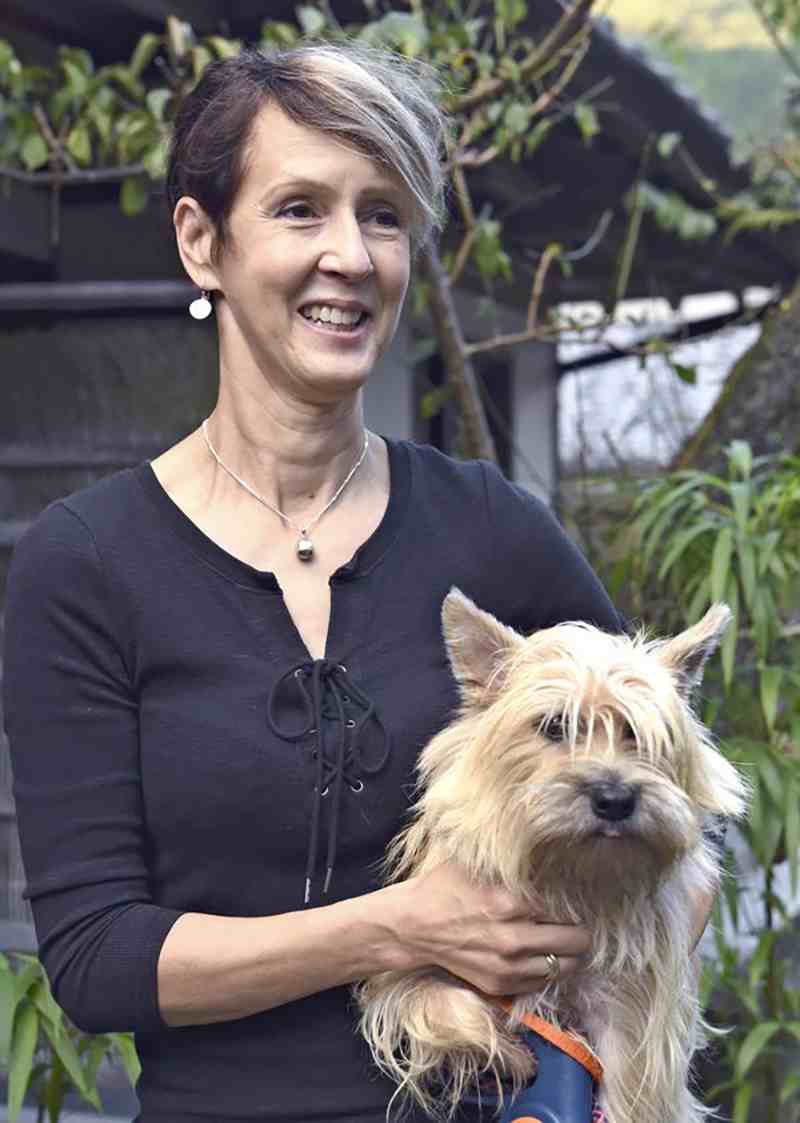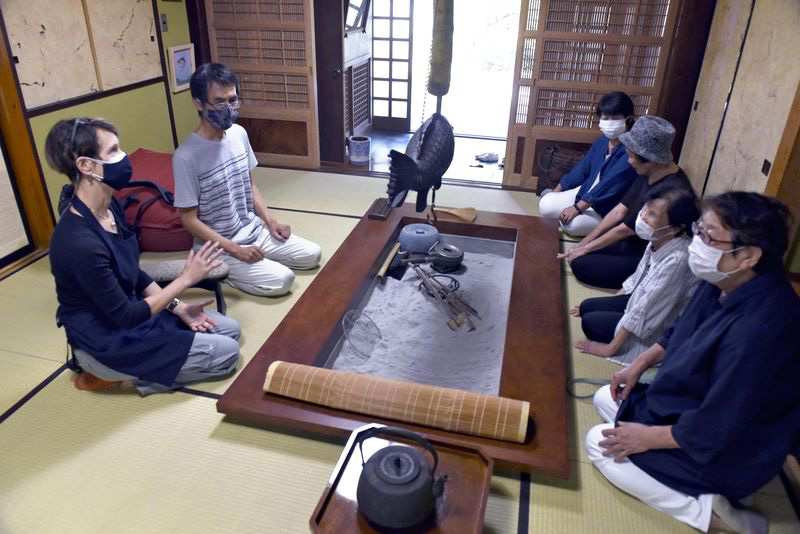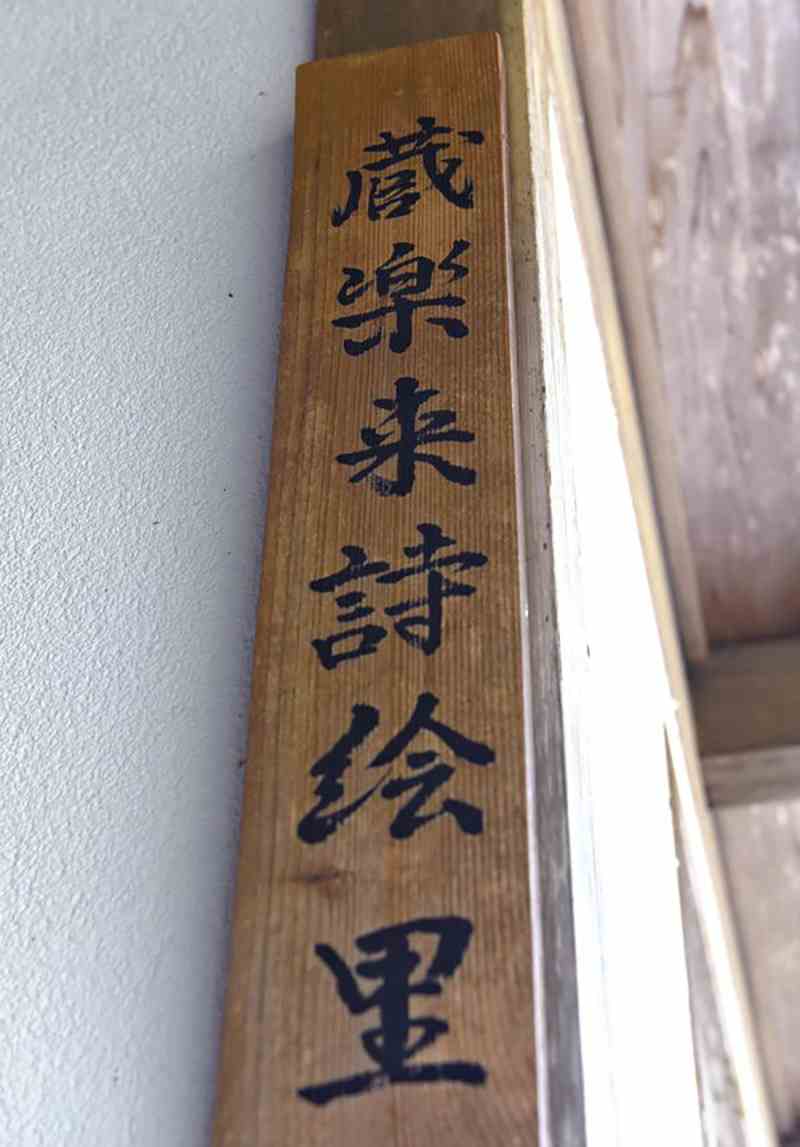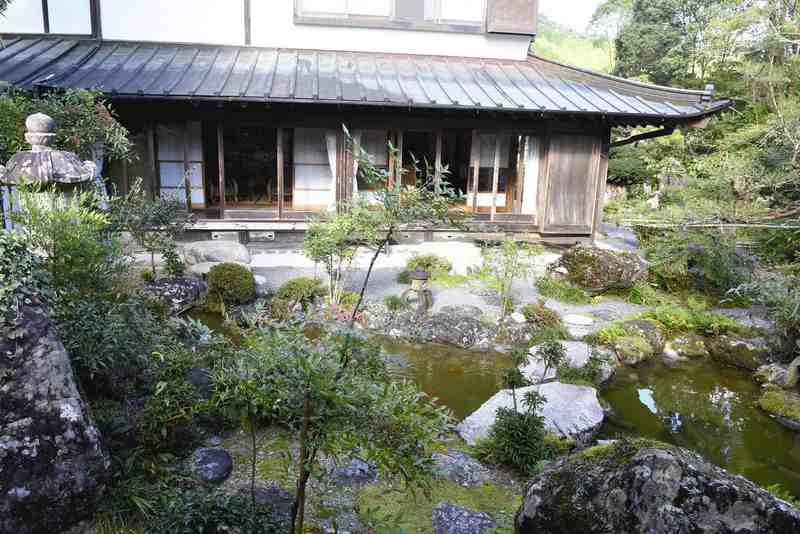
Shelley Clarke holds her dog Timo.
20:30 JST, January 12, 2022
SHIMADA, Shizuoka — Amid the wide array of solo lifestyles that modern people can enjoy, Shelley Clarke of the United States has certainly chosen a distinctive one. The 56-year-old American woman lives in a small mountain village in Shimada, Shizuoka Prefecture, where she teleworks for her job in fisheries resource management and operates a weekly cafe in a renovated tea house.
Clarke talked with The Yomiuri Shimbun about how she developed her interest in Japan at a young age, what led to her quiet yet busy life in Shimada, and her future plans.
Tea house at home
Clarke has a doctorate and works remotely for the U.N. Food and Agriculture Organization and other bodies. Her current home was built 65 years ago in the Sasama district, where 64% of the about 350 residents are elderly. The house is an hour’s drive from the Shimada city center.
Slim and stylish at 1.76 meters tall, Clarke has a cheerful, friendly nature. Every Saturday, she operates a cafe called Chaya Hotaru (Firefly Teahouse) in a tea house on her property.
Clarke grew up in a port town in Maine and first encountered Japan in the waters of the Bering Sea. She boarded a Japanese vessel fishing for pollock as a U.S. government observer, and was deeply impressed by the way the Japanese crew worked as a team. This cooperative working style was “something beyond” what she had seen in the United States, Clarke remembered.
Then 21 years old, Clarke soon began studying Japanese after returning to the United States.
In 1992, she visited Japan for the first time as a tourist. “Something just resonated with me,” she said.
During the trip, Clarke heard the sound of the koto at a ryokan inn where she stayed. She also felt a connection with the people she met, who were quiet, polite and respectful of each other. Clarke herself does not like to speak loudly and seems reserved for an American.
Her life as a resident of Japan started in 2003 when she took a job as a researcher at the National Research Institute of Far Seas Fisheries in Shizuoka City. She first visited Sasama through her hobby of cycling. Liking the scenery of traditional houses dotted throughout the alpine valleys and expansive tea fields, she bought a house in Sasama for ¥7 million in 2005.

The porch of Chaya Hotaru, a cafe run by Clarke in Shimada, Shizuoka Prefecture
“Americans move often, so from the start, I had no doubt that I was attracted to Sasama,” said Clarke.
Her husband, who is from Malaysia, agreed to buy the house as a holiday home.
Open lifestyle in old house
Local people welcomed the new resident, gifting her with many vegetables such as brussels sprouts, corn and shiitake mushrooms. When Clarke had a cold, they brought a nurse to check on her.
To blend into the community, Clarke decided to make her life “open.”
“I wanted to let my home be open, so I could show them how I was living and so that they could trust me,” she said.
Parties at her home were attended by 30 to 40 people. She also found “parents in Sasama” who helped her with many things, ranging from daily tasks to filling out tax forms. “The villagers are like a big family to me,” she said.
Clarke has lived in various places, including Britain, Italy and Hong Kong, and visited about 70 countries. Above all, she believed, “This is where I want to live my life because everyone welcomed me here.”
As a member of a neighborhood association, Clarke participates in village governance and community activities, including cleanups, as much as possible. She has also learned kagura, a traditional Japanese dance, which is struggling with a serious shortage of performers. Before the novel coronavirus pandemic started, she often went abroad for work, but always made sure to return to Sasama in time for the autumn festival.
“Interpersonal relationships are essential, and although my life is really busy, I don’t want local people to be disappointed, so I try my best,” she said.
Her love for Sasama deepened. However, it wasn’t the same for her husband, who couldn’t speak Japanese, so he left 10 years ago. “He couldn’t live here continuously,” she said.

Clarke, left, talks with customers by the hearth at the cafe
Clarke currently lives on the former estate of the Okamura clan. Five years ago, she purchased the property, which had fallen into disrepair after its owner died, for ¥10 million. The estate consists of 10 buildings, which include a manor house, a coach house and a tea house, on a plot of about 1,560 square meters. After renovations were completed, she moved there in February 2020.
Even before the pandemic, Clarke had been trying to find a balance between life and work in Sasama. The pandemic has allowed her to telework; she attends international conferences online and write reports. Sometimes she finishes an online meeting and goes to bed in the early hours of the morning, only for her neighbors, who woke up early, to pay her a visit.
Clarke thought ghosts might appear in the big old house where she lives alone, but these fears disappeared once she got her dog Timo, a cairn terrier. When she takes Timo for a walk, the villagers ask her such questions as “How are you?” and “Would you like some bok choy?”
Clearly Clarke is telling the truth when she says she is not lonely at all.On sunny days, she eats breakfast on a bench outside and goes cycling in the mountains. She loves to read a book amid the sound of a stream. While connected to her neighbors, she also seems to enjoy her private time.

Clarke Shelley is written in kanji on this nameplate.
Her cafe bustles with people from Shimada.
“I initially said no one would come here for sure. I never imagined that this many people would come,” said Hiroko Sawamoto, 73, who helps Clarke run the cafe.
Now, everyone in the area knows Clarke.
“At first, I was surprised [that she moved here], but she is just one of the typical residents here,” said her neighbor Shoji Tanemoto, 70.
Seeking Japanese citizenship
But, Clarke feels there is still more to do.
“There are lots of things I don’t understand, and I’m like a temporary family member. I make lots of mistakes,” she said.
For example, the villagers have subtle personal relationships that have been cultivated over time. There are certain things that everyone knows but doesn’t talk about. That sometimes leads to missteps.
So Clarke keeps working to understand the background behind these subtle relationships by talking to various people.

The old house where Clarke lives
In Sasama, Clarke has seen neighbors take elderly people who can’t drive to a hospital or a grocery store. She also wants to help such people but hasn’t been able to because she’s afraid they would decline, saying, “We’re fine.”
“I realize that it will take time for people to rely on me, but I want to create the right condition for that naturally,” she said.
In 2020, Clarke made a big decision. She had already obtained permanent residency, but decided to apply for Japanese citizenship, thinking that “I want to become 100% Japanese and live together with Sasama forever.” When she called her mother in the United States to tell her, there was a long silence. Her mother then said, “If that is your dream, then I support it.”
Clarke is now waiting for the decision, hoping to be granted Japanese citizenship soon.
2.88 mil. foreign residents in Japan
According to the Immigration Services Agency, the number of foreign residents in Japan totaled 2,887,116 at the end of 2020. The figure declined for the first time in eight years since 2012 as the entry of foreign travelers was restricted due to the pandemic.
Most foreign residents live in the Tokyo metropolitan area and other urban locations. By prefecture, the capital accounted for the highest percentage of 19.4%, followed by Aichi at 9.5% and Osaka at 8.8%.
According to the 2015 Population Census, 28% of foreign residents in Japan consisted of single-person households.
Related Tags
"Features" POPULAR ARTICLE
-

Sanrio to Open Museum in Yamanashi Pref. Dedicated to Founder, Exhibits Include Hello Kitty, Other Characters
-

Autumn Foliage Surrounds Visitors to Tokyo’s Showa Kinen Park
-

My Daughter No Longer Speaks to Me, But I Want to See Her and My Grandchild
-

Kumamoto: Public Bath Refurbished as Library Where You Can Chat, Take Photos
-

Frozen Vegetables: Demand Rises for Convenient, Tasty Domestic Produce
JN ACCESS RANKING
-

Tokyo Economic Security Forum to Hold Inaugural Meeting Amid Tense Global Environment
-

Keidanren Chairman Yoshinobu Tsutsui Visits Kashiwazaki-Kariwa Nuclear Power Plant; Inspects New Emergency Safety System
-

Imports of Rare Earths from China Facing Delays, May Be Caused by Deterioration of Japan-China Relations
-

University of Tokyo Professor Discusses Japanese Economic Security in Interview Ahead of Forum
-

Japan Pulls out of Vietnam Nuclear Project, Complicating Hanoi’s Power Plans




























